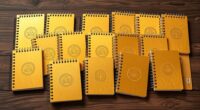If you’re looking to unseal your dreaming potential, these 12 guidebooks offer beginner-friendly techniques, practical exercises, and inspiring stories to help you start lucid dreaming. From simple reality checks to sleep science, each book provides tools to build dream recall, confidence, and control. Whether you’re interested in the science, spirituality, or creative aspects, you’ll find resources tailored to your journey. Continue exploring to discover how these guides can transform your nights into an adventure.
Key Takeaways
- The best books offer practical, beginner-friendly techniques like reality checks, dream journaling, and sleep habits to enhance lucid dreaming skills.
- They combine scientific insights, spiritual perspectives, and personal stories to provide a well-rounded approach for diverse readers.
- Many include structured plans, exercises, and visual aids to motivate and guide consistent practice toward unlocking dream potential.
- Top guides feature additional resources such as apps, worksheets, and community support to deepen learning and engagement.
- They cater to different preferences, from easy-to-understand instructions for beginners to in-depth techniques for advanced dreamers.
A Beginner’s Guide to Lucid Dreaming
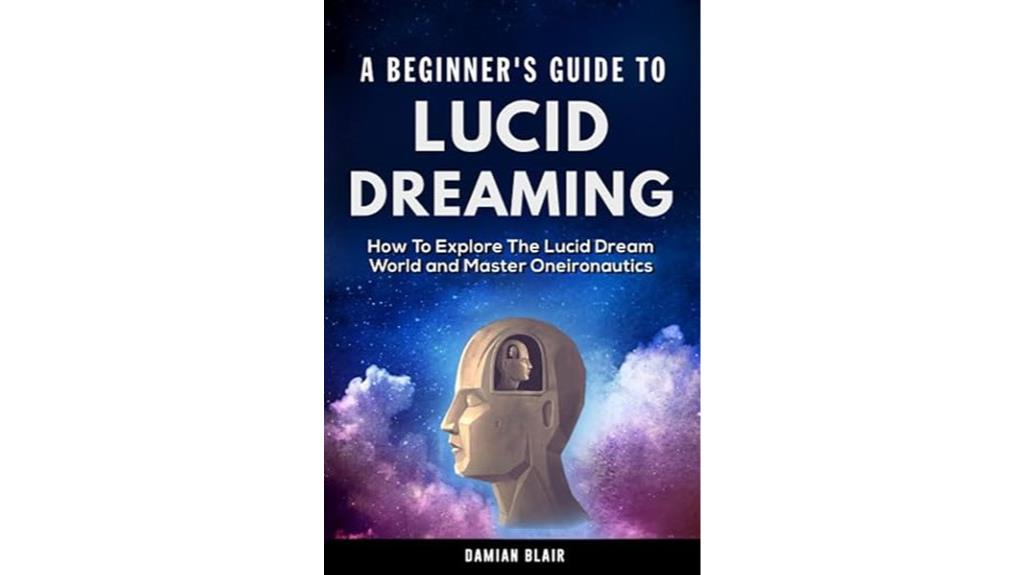
If you’re new to dreaming or want to explore the fascinating world of lucid dreams, this guidebook is an excellent starting point. I found it incredibly accessible, even if you’re just beginning. It explains how lucid dreaming works and highlights its benefits, like personal growth and overcoming fears. The book introduces simple techniques such as reality checks and dream journaling that boost dream recall and help you become aware in your dreams. I appreciated how straightforward and practical the advice was, making it easy to practice consistently. Whether you’re curious or serious about mastering your dreams, this guide offers a solid foundation to discover your full dreaming potential.
Best For: Beginners interested in understanding and exploring lucid dreaming as a tool for personal growth and self-awareness.
Pros:
- Easy-to-understand explanations and practical techniques suitable for newcomers
- Focus on building dream recall and lucidity through simple, consistent practices
- Emphasizes personal development benefits like overcoming fears and enhancing creativity
Cons:
- May lack in-depth advanced techniques for experienced lucid dreamers
- Some readers might desire more scientific background or detailed explanations
- The focus is primarily on beginners, so seasoned dreamers might find it too basic
Lucid Dreaming: Unlocking the World Within (2 Books in 1)
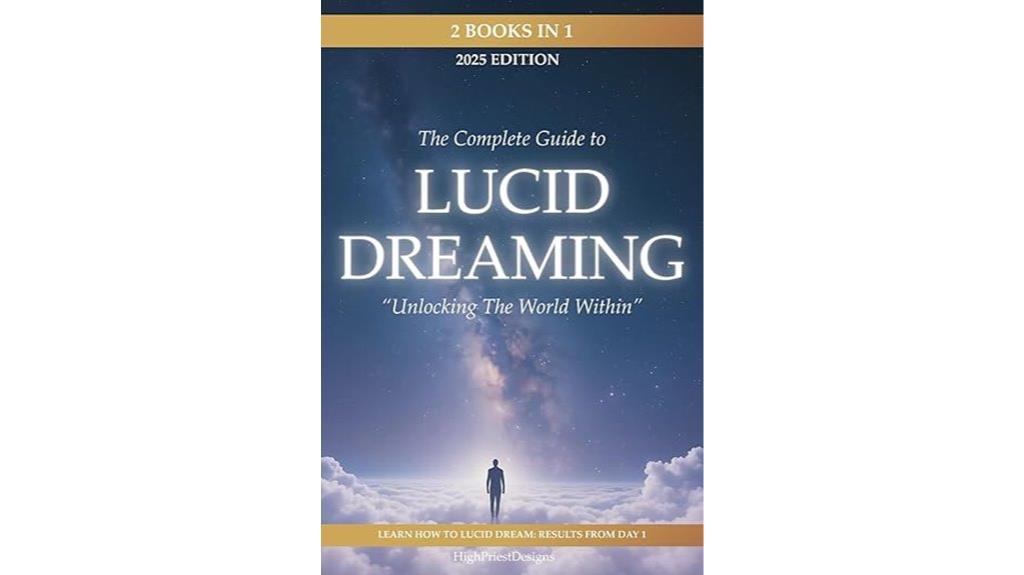
Lucid Dreaming: Opening the World Within (2 Books in 1) is an ideal choice for beginners and curious dreamers enthusiastic to explore their inner worlds. This all-encompassing guide introduces the science behind dreaming and shows how to become aware during dreams, offering practical techniques like visualization, meditation, and dream journaling. It provides a structured 30-day plan to help you develop lucid dreaming skills step-by-step. Balancing scientific facts with mystical insights, the book encourages emotional healing, creativity, and self-discovery. Its friendly tone and user-friendly design make it accessible and inspiring, making it a valuable resource for anyone ready to access the power of their dreams.
Best For: beginners and curious dreamers eager to explore and control their dreams while gaining insights into personal growth and creativity.
Pros:
- Clear, well-structured guidance suitable for novices.
- Combines scientific explanations with spiritual and mystical insights.
- Includes practical techniques, daily prompts, and a structured 30-day challenge to build skills gradually.
Cons:
- May require consistent practice and patience before seeing significant results.
- Some readers might find the balance between science and spirituality less focused for purely scientific inquiry.
- Digital format may not appeal to those who prefer physical books or journals.
A Field Guide to Lucid Dreaming: Mastering the Art of Oneironautics
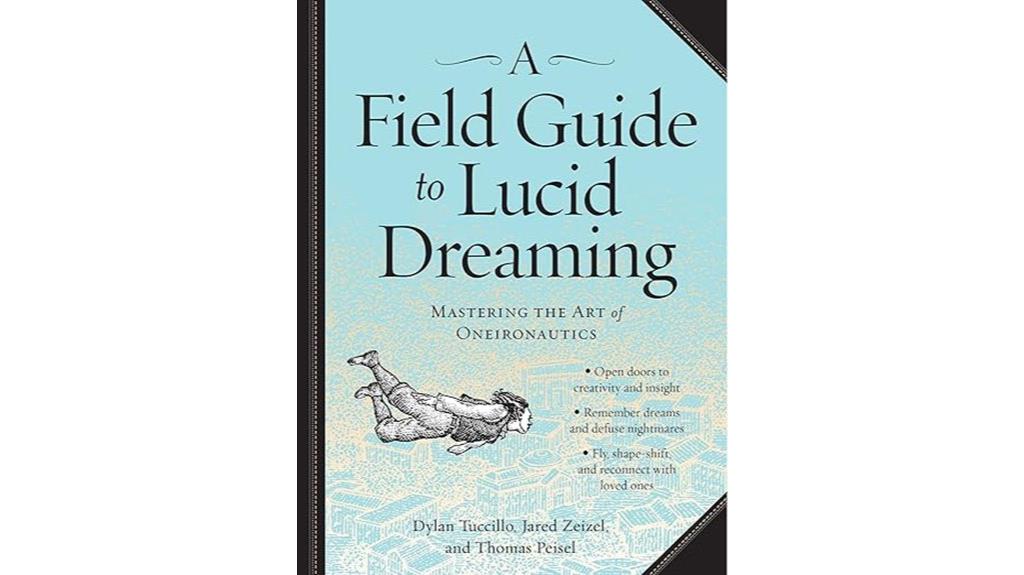
A Field Guide to Lucid Dreaming: Mastering the Art of Oneironautics stands out as an ideal choice for beginners and experienced dreamers alike who want an engaging, approachable introduction to lucid dreaming. This book offers a story-like format with illustrations, making complex ideas easy to grasp. It covers practical techniques like reality checks and DILD, which account for most lucid dreams, and shares personal stories that inspire confidence. The book emphasizes lucid dreaming’s benefits—self-discovery, creativity, and healing—while encouraging mindfulness and intentional exploration. Its clear, entertaining style helps readers unleash their dreaming potential and become confident onironauts.
Best For: beginners and experienced dreamers seeking an engaging, accessible, and visually appealing guide to mastering lucid dreaming and exploring their inner worlds.
Pros:
- Well-structured, easy-to-understand language with engaging storytelling and illustrations
- Practical techniques like reality checks and DILD emphasized, suitable for most dreamers
- Promotes self-discovery, creativity, healing, and personal growth through lucid dreaming
Cons:
- May lack in-depth scientific explanations for advanced lucid dreaming techniques
- Focuses primarily on beginner to intermediate methods, less on rare or complex approaches
- Some readers might find the story-like format less suitable for purely technical or research-oriented interests
Lucid Dreaming

Are you curious about how to gain control over your dreams and explore your inner mind? Lucid dreaming is a skill you can develop through dedicated practice, as explained by leading researcher Stephen LaBerge. His scientific methods emphasize techniques like dream recall, reality checks, and effort, making lucid dreaming accessible even for beginners. It’s useful for problem-solving, self-exploration, and transforming nightmares into positive experiences. While rooted in science, LaBerge also acknowledges spiritual perspectives, viewing dreams as valuable personal tools. With consistent practice, you can achieve lucid states several times a month, reveal your dreaming potential and gaining unprecedented insight into your subconscious.
Best For: beginners and curious individuals interested in scientifically learning how to induce and control lucid dreams for personal growth, problem-solving, and nightmare management.
Pros:
- Clear, straightforward techniques suitable for beginners.
- Supported by verifiable scientific research and expert guidance.
- Useful for a variety of applications including self-exploration and nightmare transformation.
Cons:
- Some editions lack supplemental materials like audio guides.
- Focus on science may not satisfy those seeking spiritual or religious perspectives.
- Outdated references or formatting issues in some editions may require supplementing with additional resources.
LUCID DREAMING UNLOCKED: CREATE, INNOVATE & ACHIEVE WHILE YOU SLEEP
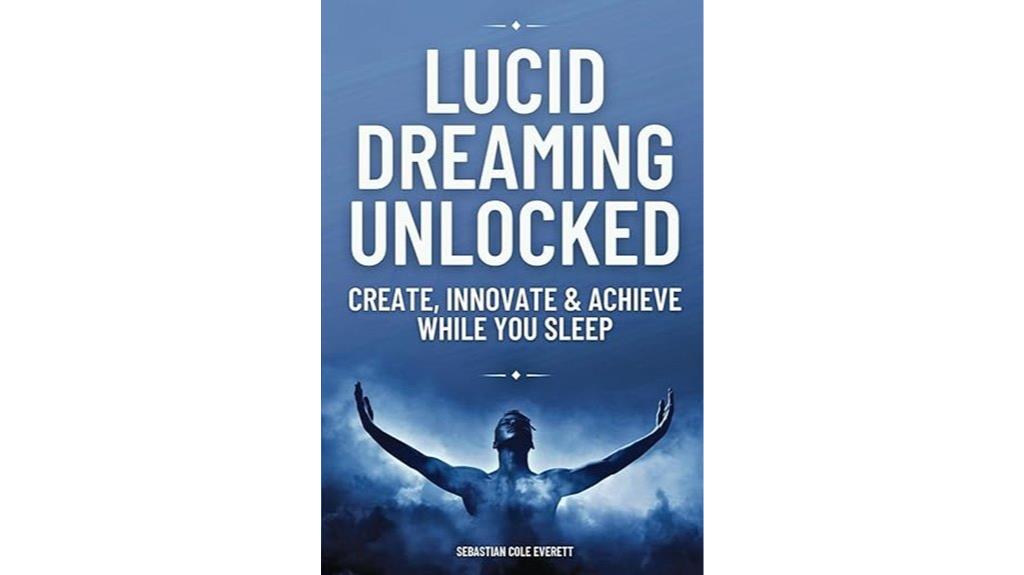
If you’re eager to open the full potential of your dreams, “Lucid Dreaming Unlocked” is an ideal guide for beginners and those new to lucid dreaming. I found this book incredibly accessible, breaking down complex ideas into simple, practical techniques. It shows how becoming aware within dreams can help you create, innovate, and solve problems while you sleep. The tools I learned boosted my confidence and allowed me to transform nightmares into empowering experiences. This book proves that sleep isn’t just rest—it’s a powerful resource for personal growth, creativity, and achievement. It’s an inspiring, straightforward guide to unlocking your subconscious potential.
Best For: beginners and newcomers interested in exploring and harnessing the power of lucid dreaming for personal growth, creativity, and problem-solving.
Pros:
- Easy-to-understand techniques that make lucid dreaming accessible for all skill levels
- Helps improve dream clarity, confidence, and control over dream experiences
- Encourages personal development by transforming nightmares into empowering experiences
Cons:
- May require consistent practice to achieve noticeable results
- Some readers might find it challenging to apply techniques without prior experience
- The effectiveness of methods can vary depending on individual sleep patterns and subconscious receptivity
A Beginner’s Guide to Lucid Dreaming
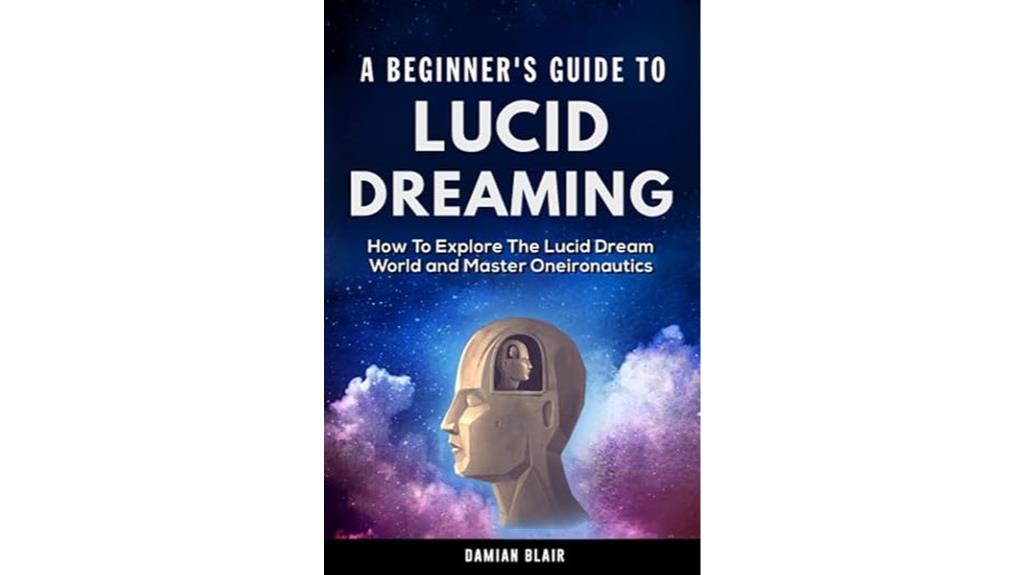
For beginners interested in exploring the world of lucid dreaming, this guidebook offers a straightforward and approachable starting point. It introduces lucid dreaming as a way to gain awareness and control over your dreams, revealing potential for self-discovery and personal growth. The book covers practical techniques like reality checks and dream journaling, making it easy to enhance dream recall and achieve lucidity. Its clear, step-by-step instructions help newcomers build confidence and skills. Whether you’re curious about facing fears, practicing skills, or exploring your subconscious, this guide provides simple, actionable strategies to begin your journey into lucid dreaming.
Best For: beginners and curious individuals seeking a clear, practical introduction to understanding and controlling their dreams for personal growth.
Pros:
- Easy-to-understand, step-by-step guidance suitable for newcomers
- Practical techniques like reality checks and dream journaling to enhance dream recall and lucidity
- Focuses on personal development, self-awareness, and overcoming fears through lucid dreaming
Cons:
- May not delve deeply into advanced lucid dreaming techniques for experienced dreamers
- Some readers might find the content too simplified if they already have some background in dreaming practices
- Limited focus on scientific explanations or detailed psychological insights
A Visionary Guide to Lucid Dreaming
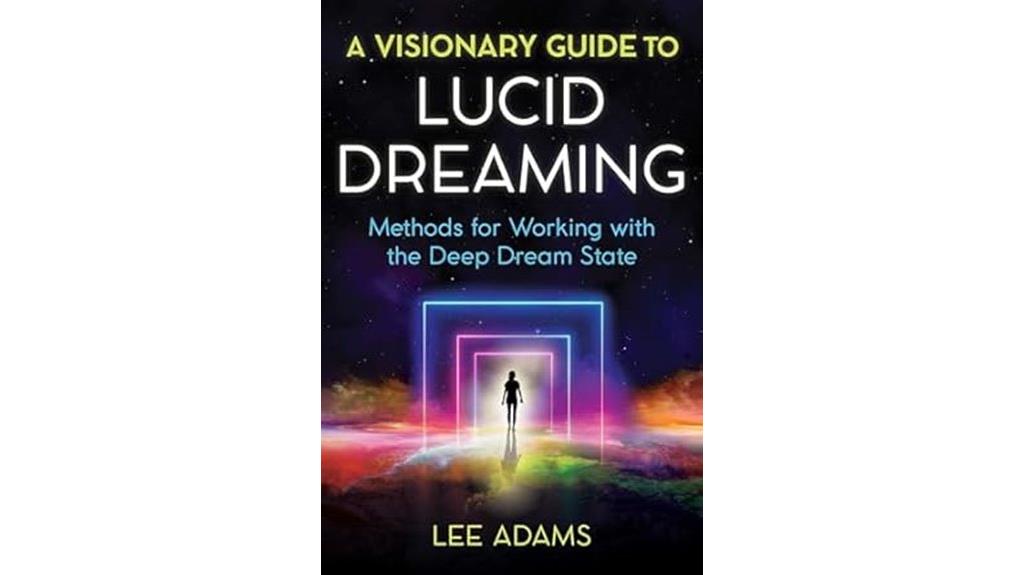
A Visionary Guide to Lucid Dreaming stands out as an ideal resource for both beginners and experienced dreamers seeking a thorough yet accessible overview of the practice. I found it inspiring, engaging, and easy to follow, with many readers purchasing physical copies despite digital options. The author’s conversational tone makes complex topics simple and relatable, earning praise from professionals, including a sleep medicine expert with 24 years of experience. Covering everything from dream recall and sleep habits to supplements and cultural insights, it offers practical, adaptable steps for expanding your practice. This book truly encourages a personal, exploratory approach to *accessing* the full potential of lucid dreaming.
Best For: anyone interested in exploring lucid dreaming, from beginners seeking foundational knowledge to experienced dreamers looking for practical guidance and cultural insights.
Pros:
- Approachable writing style makes complex topics easy to understand for all levels
- Comprehensive coverage of techniques, supplements, and sleep science enhances practical application
- Encourages a personal, exploratory approach to dreaming, fostering ongoing interest and growth
Cons:
- Some readers find parts of the book less engaging or overly detailed, leading to a sense of boredom
- The broad scope may feel overwhelming for those seeking a quick, straightforward guide
- Occasional lack of persuasive elements might leave some readers wanting more motivation or scientific backing
Astral Projection and Lucid Dreaming Book
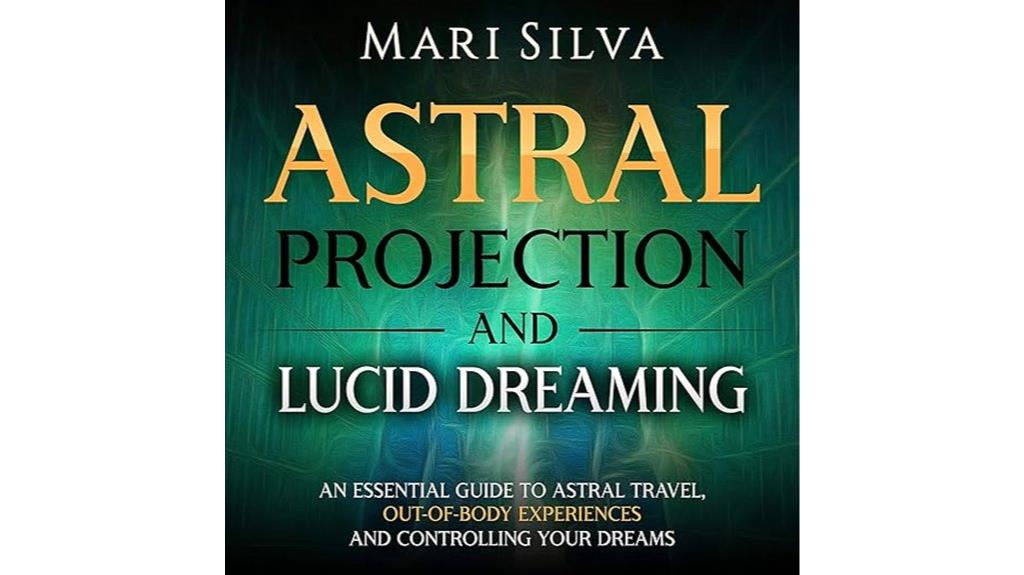
The Astral Projection and Lucid Dreaming Book stands out as an ideal resource for those seeking practical, no-nonsense guidance on exploring the astral domain and controlling dreams. It offers clear, straightforward techniques for both beginners and advanced practitioners, focusing on how to achieve astral travel and enhance dream mastery. I appreciate its emphasis on actionable methods rather than spiritual debates, making it highly accessible. The book covers a wide range of topics, from basic concepts to complex techniques, including related spiritual ideas like chakras and auras. It’s praised for its depth, clarity, and utility, making it a top choice for anyone serious about exploring their dreaming potential.
Best For: individuals interested in practical, straightforward guidance on exploring astral projection and lucid dreaming without engaging in spiritual debates.
Pros:
- Clear and accessible techniques suitable for beginners and advanced practitioners
- Focuses on actionable methods rather than spiritual or philosophical discussions
- Covers a wide range of topics including astral travel, lucid dreaming, chakras, and auras
Cons:
- Does not delve into the spiritual or metaphysical reasons behind astral projection
- Some readers might prefer more spiritual or philosophical context
- Advanced techniques may require practice and patience to master
The Lucid Dreaming Workbook, Step-by-Step Guide
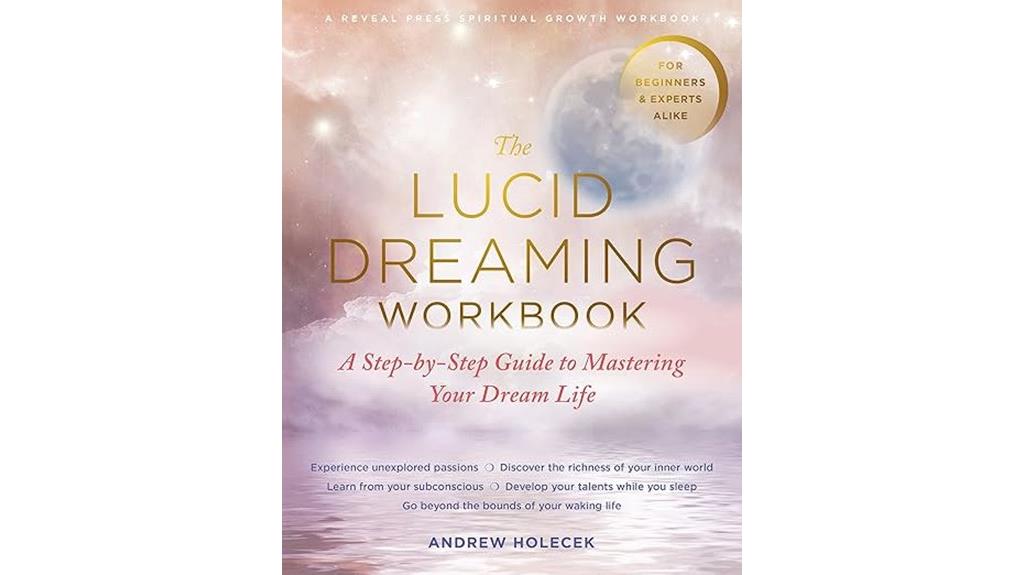
If you’re enthusiastic to explore lucid dreaming through a structured, practical approach, “The Lucid Dreaming Workbook” by Andrew Holecek offers a clear, step-by-step guide that’s ideal for beginners and experienced dreamers alike. This book combines scientific, Eastern, and Western methods, providing practical exercises, sleep hygiene tips, and solutions for common issues like insomnia. It emphasizes that lucid dreaming isn’t just about nighttime awareness but a tool for self-discovery and real-life insight. Designed as a flexible “Pick Your Own Adventure,” it encourages personalized exploration and helps deepen your understanding of dreams, consciousness, and how they relate to waking life.
Best For: beginners and experienced dreamers seeking a practical, personalized guide to exploring lucid dreaming and consciousness.
Pros:
- Combines scientific, Eastern, and Western methods for a well-rounded approach
- Offers practical exercises, sleep hygiene tips, and solutions for common sleep issues
- Encourages personalized exploration with a flexible “Pick Your Own Adventure” format
Cons:
- Some content may be redundant or overly detailed, potentially slowing progress
- Certain techniques might feel too meditative or less practical for immediate results
- Some readers may find parts of the book more focused on meditation than direct dreaming practices
Lucid Dreaming Beginners Guide to Controlling Dreams

Are you a beginner enthusiastic to learn how to control your dreams? Layla Moon’s “Lucid Dreaming” makes it approachable, explaining what lucid dreaming is and how it can boost creativity, healing, and self-awareness. The book offers simple techniques like reality checks, dream journaling, meditation, and affirmations to help you induce lucid dreams. While some steps may feel familiar, the clear instructions make the process less intimidating. It also encourages exploring your subconscious, providing insights into personal messages within dreams. Overall, this guide is an inspiring, easy-to-understand starting point for gaining control over your dreams and releasing your inner potential.
Best For: beginners interested in learning accessible, practical ways to explore and control their dreams for personal growth and creativity.
Pros:
- Clear, simple language makes complex concepts easy to understand
- Practical techniques like reality checks and dream journaling are easy to incorporate into daily routines
- Emphasizes subconscious exploration and personal growth beyond just controlling dreams
Cons:
- Some steps are repetitive or familiar from other sources
- Certain sections may lack in-depth detail for advanced dreamers
- Achieving lucid dreams can still be challenging despite straightforward instructions
Lucid Dreaming and Living Guidebook with 44 Cards

Anyone interested in deepening their understanding of lucid dreaming and conscious living will find the Lucid Dreaming and Living Guidebook with 44 cards to be an invaluable resource. This set combines stunning full-color cards with a detailed 200-page guidebook, designed to inspire both dreamers and seekers of consciousness. The cards, divided into three categories, make learning intuitive and enjoyable, while the guide offers practical tips, symbolism explanations, and techniques for achieving lucidity. Users report personal breakthroughs, like recognizing dreams within dreams and improving dream control. Although some find the card stock flimsy, the overall spiritual depth and versatility make this deck a powerful tool for exploring dreams and conscious living.
Best For: individuals interested in deepening their understanding of lucid dreaming, conscious living, and spiritual exploration seeking a beautiful, comprehensive tool for dream awareness and personal growth.
Pros:
- Stunning full-color artwork that enhances the dream transition experience
- Combines practical guidance with spiritual depth, suitable for beginners and experienced dreamers alike
- Facilitates intuitive learning and personal breakthroughs in lucid dreaming
Cons:
- Card stock is reported to be flimsy, which may affect durability
- Some users may find the deck’s structure non-linear, requiring patience for progressive mastery
- The premium aesthetic might not fully compensate for the material quality concerns
Lucid Dreaming Beginner’s Guide to Controlling Dreams
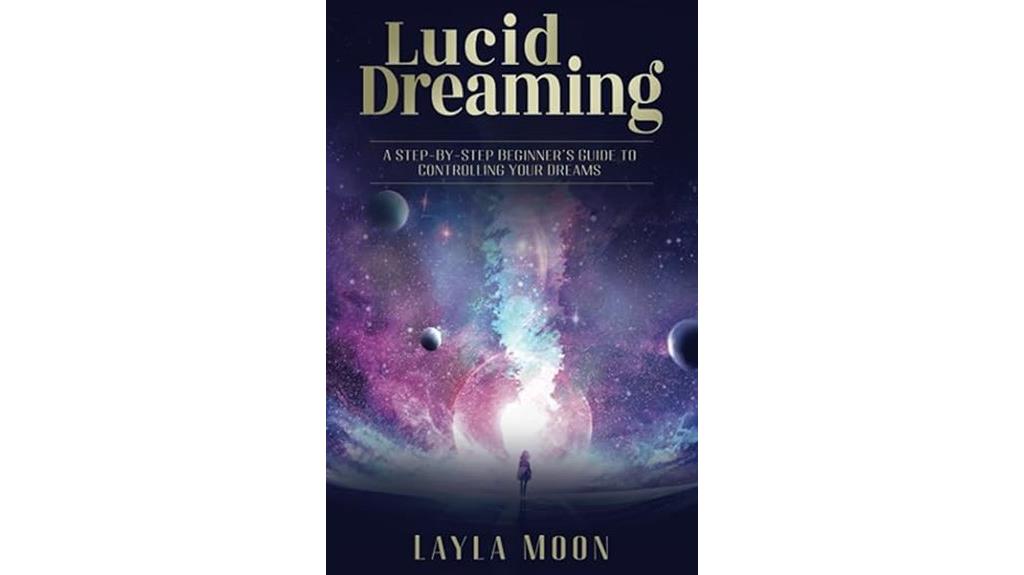
Layla Moon’s “Lucid Dreaming” is an ideal starting point for beginners enthusiastic to learn how to control their dreams. It explains lucid dreaming simply, covering its types and benefits like creativity and healing. The book provides practical techniques such as meditation, dream journaling, reality checks, and affirmations, making them easy to add to your routine. It emphasizes exploring your subconscious and analyzing dreams for personal growth. While some steps are familiar, the clear instructions boost confidence. Overall, this guide makes lucid dreaming feel achievable, inspiring you to develop control over your dreams for self-discovery and transformation.
Best For: beginners interested in learning how to control and explore their dreams for personal growth, creativity, and self-discovery.
Pros:
- Clear and simple language that makes complex concepts accessible
- Practical techniques like meditation, dream journaling, and reality checks that are easy to implement
- Emphasizes subconscious exploration and personal development
Cons:
- Some steps may feel familiar or basic to experienced lucid dreamers
- Certain content might lack in-depth detail for advanced practitioners
- Repetition of concepts could reduce engagement for some readers
Factors to Consider When Choosing Lucid Dreaming Guide Books

When selecting a lucid dreaming guide book, I look at the author’s expertise and credibility to guarantee reliable advice. I also consider whether the book offers a variety of techniques that suit different learning styles and if it’s accessible for beginners. Additionally, I pay attention to how well it explains scientific concepts and whether the layout makes the information easy to follow.
Author Expertise and Credibility
Choosing a lucid dreaming guide book becomes more reliable when you consider the author’s expertise and credibility. I look for authors with solid backgrounds in sleep science, psychology, or dream research, often holding Ph.D. degrees or professional experience. Practical experience with lucid dreaming techniques or personal practice also adds trustworthiness. I check if the author has published multiple reputable works or research articles related to dreaming or subconscious phenomena. A balanced approach that combines scientific rigor with accessible explanations signals a well-rounded understanding. Additionally, endorsements from sleep or psychology experts help confirm credibility within the scientific community. Overall, an author’s qualifications and reputation are key indicators of whether the book will provide reliable, effective guidance for accessing your dreaming potential.
Technique Variety and Effectiveness
A well-rounded lucid dreaming guide should offer a diverse range of techniques, such as reality checks, dream journaling, visualization, and meditation, to suit different learning styles and preferences. Since the effectiveness of these methods varies between individuals, it’s important the book explains which techniques might work best for you—whether it’s WILD, MILD, or simpler practices like affirmations. Practical exercises with clear, step-by-step instructions increase your chances of success and help reinforce your skills. Some guides combine traditional approaches with modern tools like apps or sleep devices, adding versatility. Additionally, understanding the scientific principles behind each technique helps you adapt methods to your unique sleep patterns, making your journey to lucid dreaming more effective and personalized.
Accessibility for Beginners
Selecting a lucid dreaming guide that’s accessible for beginners often means looking for books that speak your language—literally. I recommend choosing books with simple, clear language that avoid technical jargon, making concepts easier to grasp. Step-by-step instructions and practical exercises are essential—they help you implement techniques daily without feeling overwhelmed. Visual aids, such as diagrams or illustrations, can clarify complex ideas and boost understanding. It’s also helpful to pick guides that provide basic foundational information, assuming no prior knowledge. The tone matters, too: a friendly, engaging style encourages you to practice consistently and stay motivated. Ultimately, the best beginner guide feels approachable, straightforward, and supportive, helping you build confidence as you start your lucid dreaming journey.
Depth of Scientific Explanation
If you’re interested in understanding how lucid dreaming works from a scientific standpoint, look for guides that explore the brain’s activity during sleep, especially during REM phases. These books typically include references to sleep cycles, brain regions involved in dreaming, and neurological processes that enable conscious awareness within dreams. They often cite research studies, experiments, and expert theories, providing a solid foundation grounded in sleep science. Such guides tend to explain how practices like reality checks or dream journaling influence brain activity and improve dream recall. If you’re seeking a clear understanding of the physiological mechanisms behind lucid dreaming, choose books that incorporate diagrams, data, and scientific references to make complex concepts more accessible and credible.
Visual Design and Layout
When choosing a lucid dreaming guide book, paying attention to its visual design and layout can make a significant difference in how effectively you learn and retain information. An appealing layout with clear headings and organized sections helps you navigate complex concepts easily. Visual aids like diagrams, illustrations, or infographics support understanding of techniques such as reality checks or dream journaling. Consistent font styles, sizes, and spacing create a clean, comfortable reading experience, reducing eye strain and boosting comprehension. Incorporating visual cues like symbols or color coding reinforces key ideas and enables quick referencing. Well-designed books strike a balance between text and visuals, keeping beginners engaged and enhancing their learning process through visual learning aids that clarify and simplify complex topics.
Practical Application Focus
Choosing the right lucid dreaming guide book means focusing on practical, actionable techniques that you can easily apply in daily life. I look for books that provide clear, step-by-step instructions for inducing lucid dreams, so I can follow them confidently. Exercises like reality checks and dream journaling are essential, as they’re proven methods to boost your skills. I prioritize guides that emphasize consistent practice and habit-building because regular effort is key to success. It’s also helpful if the book offers tools or routines that fit easily into everyday routines, making the techniques easier to sustain. Ultimately, I want a resource that focuses on real-world application, giving me practical advice rather than just theory, so I can access my dreaming potential effectively.
Supplementary Resources Offered
Have you considered how supplementary resources can enhance your lucid dreaming journey? Many guidebooks include tools like dream journals, practice worksheets, or guided exercises that boost learning and consistency. Additional materials like audio recordings, meditation guides, or online communities can keep you motivated and support skill development. Some books offer access to mobile apps or digital tools, making it easier to track dreams, perform reality checks, or visualize techniques. Interactive elements such as quizzes, daily prompts, or reflection exercises deepen your understanding and keep you engaged. Bonus content like video tutorials, webinars, or downloadable PDFs can substantially improve practical application and overall value. These extras turn a good guidebook into a comprehensive resource, making your lucid dreaming experience more effective and enjoyable.
Frequently Asked Questions
How Do I Choose the Best Lucid Dreaming Book for My Skill Level?
When choosing a lucid dreaming book, I consider my current skill level and what I hope to learn. Beginners should look for guides that explain basics clearly and offer simple exercises, while more advanced dreamers might prefer books with in-depth techniques and scientific insights. I also check reviews to see if the book matches my experience and goals. Picking the right book helps me progress faster and enjoy my lucid dreaming journey.
Are There Specific Books That Teach Both Lucid Dreaming and Astral Projection?
Did you know that over 50% of lucid dreamers also explore astral projection? I’ve found some books that teach both, like Robert Bruce’s “Astral Dynamics” and “Lucid Dreaming: Gateway to the Inner Self” by Robert Waggoner. These guides delve into techniques for both, helping you expand your consciousness. If you’re interested in exploring these domains, I recommend starting with these all-encompassing resources—they’ve truly expanded my understanding.
Which Guide Books Include Practical Exercises for Beginners?
You’re wondering which guide books offer practical exercises for beginners. I’ve found that books like “Lucid Dreaming for Beginners” by Jason Quin and “A Field Guide to Lucid Dreaming” by Dylan Tuccillo include clear, step-by-step exercises. These guides walk you through techniques like reality checks and wake-back-to-bed, making it easier to start your lucid dreaming journey. They’re perfect for anyone just getting started and enthusiastic to practice.
Do Any Books Address Overcoming Common Lucid Dreaming Challenges?
Did you know that nearly 70% of beginners face challenges like false awakenings or difficulty maintaining lucidity? I’ve found that some guidebooks specifically address these issues, offering practical tips to overcome them. I recommend books that include troubleshooting sections and real-life strategies, as they help build confidence and resilience. These resources make it easier to navigate common hurdles, turning frustrating moments into opportunities for deeper, more consistent lucid dreaming experiences.
Can These Books Help Improve Dream Recall and Dream Control Skills?
Absolutely, these books can really boost your dream recall and control skills. I’ve found that they offer practical tips and techniques that help me remember dreams more vividly and manipulate them with greater ease. By following their advice, I’ve improved my ability to stay aware during dreams and shape my experiences. If you’re serious about enhancing your lucid dreaming, these guides are valuable resources that can make a real difference.
Conclusion
Think of these guide books as your map and compass on a journey through the vast, uncharted realm of your dreams. Each page is a stepping stone, guiding you closer to mastering your dreaming world. With the right tools, you’ll navigate this inner landscape with confidence and curiosity. So, pick your guide, set your intention, and set out—your dream adventure awaits, ready to reveal its secrets and unlock your true potential.


